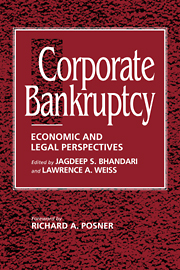Book contents
- Frontmatter
- Contents
- List of tables and figures
- Foreword by the HONORABLE RICHARD A. POSNER
- Preface
- Part I The role of credit
- Part II Bankruptcy as a reflection of the creditors' implicit bargain
- Part III Beyond the basic creditors' bargain
- 9 Bargaining after the fall and the contours of the absolute priority rule
- 10 On the nature of bankruptcy: An essay on bankruptcy sharing and the creditors' bargain
- 11 A simple noncooperative bargaining model of corporate reorganizations
- 12 Commentary on “On the nature of bankruptcy”: bankruptcy, priority, and economics
- 13 Bankruptcy and risk allocation
- 14 The corporate bankruptcy decision
- 15 Bargaining over equity's share in the bankruptcy reorganization of large, publicly held companies
- 16 Bankruptcy resolution: Direct costs and violation of priority of claims
- 17 The costs of conflict resolution and financial distress: Evidence from the Texaco-Pennzoil litigation
- 18 Survey of evidence on business bankruptcy
- Part IV Workouts or bargaining in the shadow of bankruptcy
- Part V Alternatives to bankruptcy and the creditors' bargain
- Part VI Experience of other countries
- Index
18 - Survey of evidence on business bankruptcy
Published online by Cambridge University Press: 10 December 2009
- Frontmatter
- Contents
- List of tables and figures
- Foreword by the HONORABLE RICHARD A. POSNER
- Preface
- Part I The role of credit
- Part II Bankruptcy as a reflection of the creditors' implicit bargain
- Part III Beyond the basic creditors' bargain
- 9 Bargaining after the fall and the contours of the absolute priority rule
- 10 On the nature of bankruptcy: An essay on bankruptcy sharing and the creditors' bargain
- 11 A simple noncooperative bargaining model of corporate reorganizations
- 12 Commentary on “On the nature of bankruptcy”: bankruptcy, priority, and economics
- 13 Bankruptcy and risk allocation
- 14 The corporate bankruptcy decision
- 15 Bargaining over equity's share in the bankruptcy reorganization of large, publicly held companies
- 16 Bankruptcy resolution: Direct costs and violation of priority of claims
- 17 The costs of conflict resolution and financial distress: Evidence from the Texaco-Pennzoil litigation
- 18 Survey of evidence on business bankruptcy
- Part IV Workouts or bargaining in the shadow of bankruptcy
- Part V Alternatives to bankruptcy and the creditors' bargain
- Part VI Experience of other countries
- Index
Summary
This chapter reviews the empirical evidence concerning how firms and their creditors and equity holders fare in bankruptcy. The data come from surveys of firms that have filed for bankruptcy since the adoption of the Bankruptcy Code.
There have been two basic types of surveys. The first involves examining the records of firms that file for bankruptcy under chapter 7 or chapter 11 in a particular bankruptcy court. Since most firms that file for bankruptcy are relatively small, these surveys provide evidence concerning the characteristics of small firms in bankruptcy. The other type of survey involves large firms with publicly traded debt or equity that filed for bankruptcy, almost always under chapter 11. A variety of data sources are used to obtain information concerning large firm bankruptcies, including bankruptcy court records, annual reports, 10K filings, trading data, information from articles in The Wall Street Journal and other financial publications, and interviews with lawyers and managers.
Table 18.1 summarizes much of the information. The left column refers to characteristics of small firms that filed for bankruptcy liquidation under chapter 7, the middle column refers to characteristics of small firms that filed for bankruptcy reorganization under chapter 11, and the right column refers to characteristics of large firms that filed for bankruptcy reorganization under chapter 11. Since large firms virtually never file under chapter 7, there is no “large chapter 7” column. The reason for separating large versus small firms is that their experience in bankruptcy is generally quite different.
- Type
- Chapter
- Information
- Corporate BankruptcyEconomic and Legal Perspectives, pp. 298 - 306Publisher: Cambridge University PressPrint publication year: 1996
- 4
- Cited by



